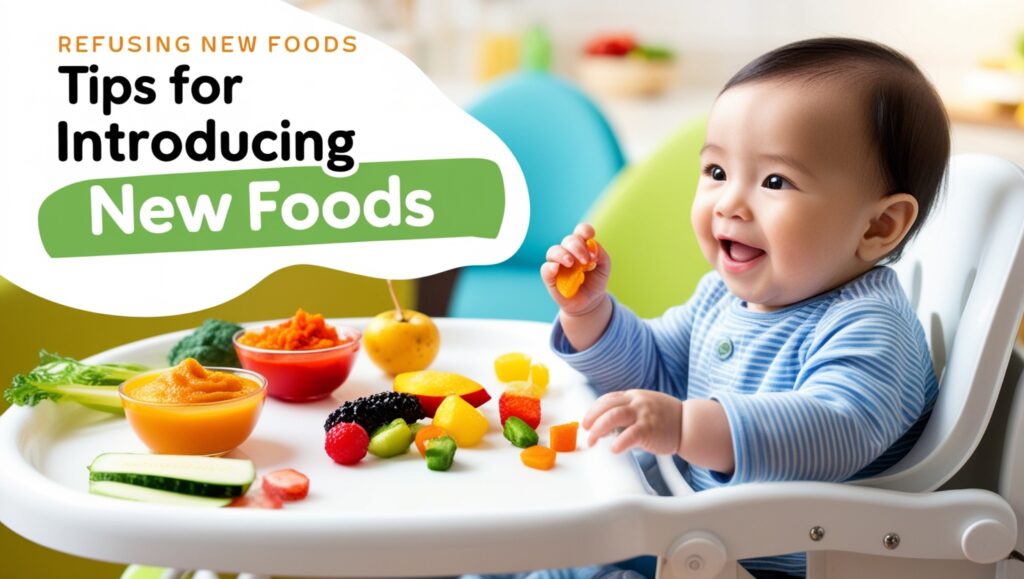Starting solids is an exciting chapter in your baby’s life. Single-ingredient purees are not just easy to prepare—they also help babies transition to solid foods while ensuring their tiny tummies adjust comfortably. Let’s dive into how you can prepare and serve these purees with confidence!
Why Start with Single-Ingredient Purees?
- Identify Allergies: A single ingredient per meal makes it easier to spot any allergic reactions.
- Simple Flavors: They help your baby develop a taste for natural, unprocessed foods.
- Gentle on Digestion: Babies’ digestive systems are still developing, and single-ingredient purees are easy to process.
Steps to Begin with Purees
1. Timing is Everything
Introduce solids when your baby is around 6 months old and shows signs like sitting up independently, showing interest in food, and losing their tongue-thrust reflex.
2. Tools You’ll Need
- Baby-friendly blender or food processor.
- Silicone-tipped spoons for easy feeding.
- Ice cube trays for freezing small portions.
3. Prep with Care
Wash fruits and vegetables thoroughly, remove seeds or peels, and cook them until soft. Avoid adding salt, sugar, or spices.
4. Follow the 3-Day Rule
Offer the same puree for 3 days before trying a new one to check for any allergic reactions.
Nutritious Single-Ingredient Puree Recipes
Banana Puree
- Why It’s Great: Packed with potassium and easy to digest.
- How to Make It: Simply mash a ripe banana until smooth. No cooking required!
Butternut Squash Puree
- Why It’s Great: Loaded with vitamin A and fiber.
- How to Make It: Roast peeled and cubed squash, then blend it into a creamy puree.
Peach Puree
- Why It’s Great: Sweet, juicy, and full of vitamin C.
- How to Make It: Peel and steam fresh peaches, then blend into a smooth consistency.
Avocado Puree
- Why It’s Great: A natural source of healthy fats for brain development.
- How to Make It: Scoop out ripe avocado and mash until smooth.
Zucchini Puree
- Why It’s Great: Light and hydrating, perfect for introducing greens.
- How to Make It: Steam zucchini slices, then blend until silky smooth.
Signs Your Baby Is Enjoying Solids
- Opens their mouth eagerly for the spoon.
- Leans forward to reach the food.
- Smiles or giggles during mealtime.
Dealing with Rejections: What to Do If Baby Doesn’t Like a Puree
It’s normal for babies to reject a food the first time. Don’t give up! Offer the same puree multiple times, and consider mixing it with a familiar taste once your baby is comfortable with multiple ingredients.
Combining Flavors Later On
Once your baby is accustomed to single-ingredient purees, you can start blending two or three flavors together to create exciting combinations:
- Sweet Potato + Apple.
- Banana + Avocado.
- Carrot + Peas.
These combinations not only enhance flavor but also boost the nutritional profile of the meal.
Quick Tips for Safe Feeding
- Always supervise your baby while eating.
- Start with a small quantity (1-2 teaspoons) and gradually increase as your baby gets used to eating solids.
- Discard any leftovers from the bowl to avoid contamination.
Common Questions About Single-Ingredient Purees
Q: How long should I blend the puree?
A: Blend until it’s completely smooth, especially in the early stages. You can gradually leave it chunkier as your baby grows.
Q: Can I use frozen fruits and vegetables?
A: Yes! Frozen produce is often picked at peak ripeness and retains most nutrients. Just thaw and cook before blending.
Q: Is it okay to add breast milk or formula to the puree?
A: Absolutely! Adding breast milk or formula can make the puree creamier and more familiar to your baby.
Bonus Recipe: Apple & Breast Milk Puree
- Ingredients: 1 apple, breast milk.
- Method: Steam a peeled, cored apple until soft. Blend with 1–2 tablespoons of breast milk to desired consistency.
Making Mealtime Special
- Create a Routine: Feed your baby at the same time every day to help them adjust.
- Make it Interactive: Talk to your baby and encourage them as they explore new flavors.
- Capture the Moments: These are milestones worth documenting!
Conclusion: A Foundation for Healthy Eating
Introducing single-ingredient purees is a simple yet impactful way to nurture your baby’s health and set the stage for a lifetime of healthy eating habits. From carrots to bananas, every spoonful is a step toward building their love for nutritious foods.

